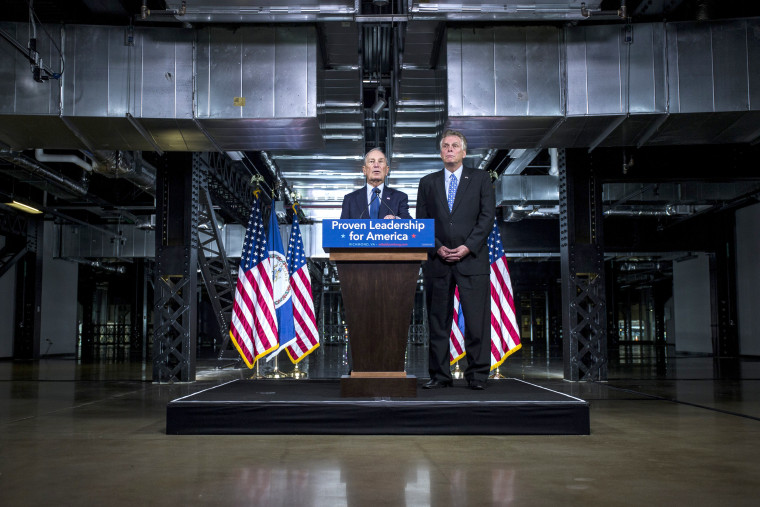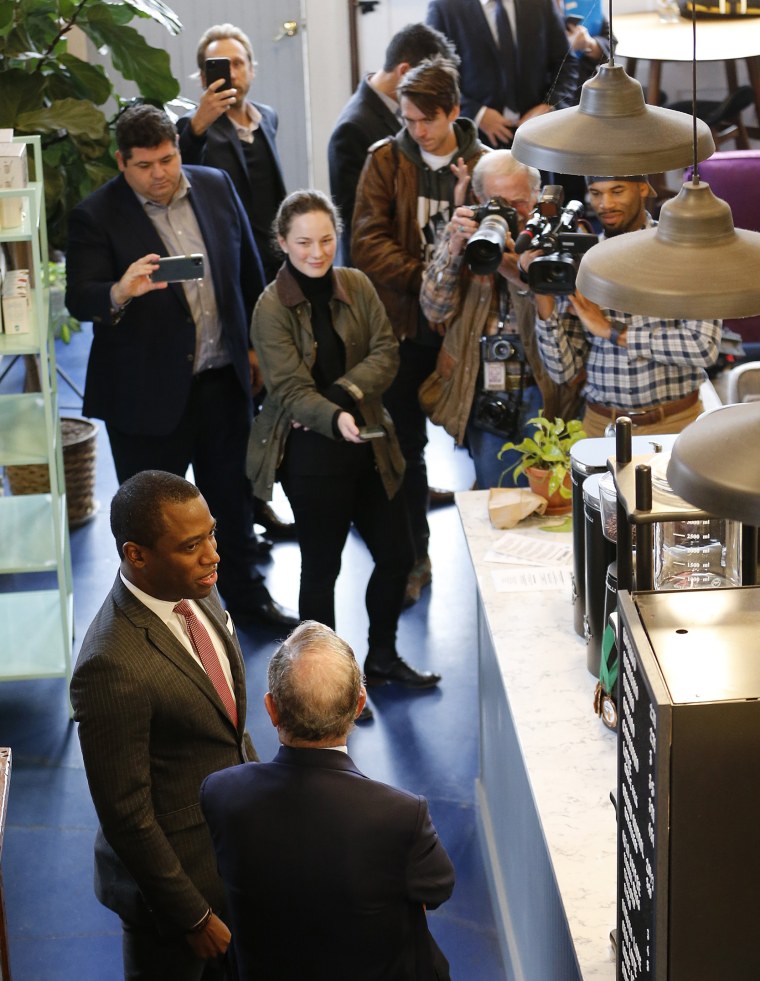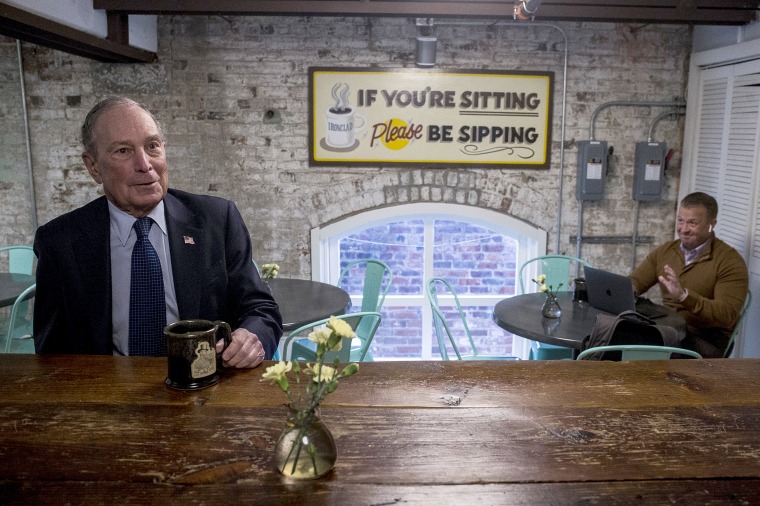RICHMOND, Va. — If you’re driving from the airport toward downtown Des Moines, Iowa and hang a right, then keep going for about 1,110 miles, you might end up at Ironclad Coffee in Virginia's capital city.
Michael Bloomberg is running for president, but the former New York City mayor wasn’t lost when he stopped here Tuesday morning for a decaf Americano — after having arrived before dawn following an overnight flight on a private jet from California — and a meeting with Richmond's mayor.
Even though Iowa’s crucial first-in-the-nation presidential caucuses are just 27 days away, Bloomberg was here — and everywhere, really, aside from Iowa and New Hampshire — waging what has to be one of the best-funded, least-conventional presidential campaigns in history.
He's trying to make an end-run to the Democratic presidential nomination around the early states by calling in all the political favors he’s accrued over the years and using his billions to run a robust operation.
On Tuesday, it was in Virginia, which holds more delegates than Iowa and New Hampshire combined and votes just after them in the Democratic primary on March 3. Bloomberg invested millions here to help Democrats successfully turn Virginia blue and push for new gun safety laws.

"I'm here today to thank Mayor Bloomberg for his consistent support," former Virginia Gov. Terry McAuliffe, who has not endorsed a candidate yet, said at an immaculately stage-managed Bloomberg campaign press conference in an otherwise dark and empty space in a converted train station.
"Candidates and people who have helped have come and gone. Mayor Bloomberg has been a steady force here in the commonwealth of Virginia," McAuliffe continued, "And he has never, ever, said no to us."
The night McAuliffe announced he would not run for president, he had dinner with a former top aide, Brynne Craig, to tell her what her new boss, Bloomberg, needed to do in Virginia.
She’s part of the juggernaut of a campaign the multibillionaire built in his less than two months in the race, which includes a mix of longtime Bloomberg loyalists, corporate expats and hired political guns, including several gleaned from other, failed 2020 campaigns.
To compensate for skipping the early states, Bloomberg is pulling double duty in the other states. And with an essentially unlimited amount of money to spend, the campaign has already taken on the size, shape and feel of a mature presidential campaign in the final stretches of the general election rather than a nascent primary bid.
He travels in a motorcade of black SUVs with a full retinue of aides, photographers and videographers, and bodyguards who dress the part of Secret Service agents, with dark suits and curlicue earpieces.
Formal press conferences are rare on the campaign trail; most candidates "gaggle" with reporters, who swarm around them at events with cameras and questions.
When Bloomberg takes questions from the press, he stands behind a podium with branded signage (even at a Mexican restaurant in Phoenix), flanked by neatly folded American flags, as an aide holds a microphone for reporters to speak.
He gets lots of press coverage wherever he goes since local reporters in the 17 states he’s visited are not used to seeing presidential candidates roll through, let alone ones worth more than $50 billion.
One crucial element is missing, though: crowds. Bloomberg isn't holding rallies or other large-scale events, which is unusual given the size of his operation. The campaign has a certain "If you build it, they will come" feel to it.

"If there’s anyone to shake hands with, we’ll do that," one staffer said to another as they went over the plan before Bloomberg arrived at the coffee shop.
The handful of people sipping tea or eating bagels seemed bewildered as cameras and well-dressed staffers suddenly swirled around them. One young man cranked up the volume of his AirPods and stared deeper into his textbook. An older couple looked around uncomfortably.
"There’s a couple sitting here and we’ve barged into their space!" Bloomberg joked.
To be fair, this was not a public event and he had some supporters turn out in California on Monday. On Tuesday, Bloomberg was meeting with Richmond Mayor Levar Stoney (Bloomberg’s largesse has bought him goodwill from mayors, many of whom have received grants from his philanthropy or attended a school for mayors he funded at Harvard.)
It's not Sen. Elizabeth Warren’s selfie line or former Vice President Joe Biden’s rope-line hugs, but touchy-feely is not part of Bloomberg’s brand.
"It was a feeling that things were run effectively and efficiently during his 12 years as mayor,” “Judge Judy” Sheindlin, Bloomberg’s highest-profile endorsement so far, explained on ABC’s "The View" on Monday.
Bloomberg’s strategy comes down to cold hard math (even if Andrew Yang has already cornered the branding on that.)
Candidates need a majority of delegates to win the nomination and the early states don’t actually have that many. Winning them is more about momentum and media attention than delegates.
Only about 4 percent of delegates are at stake in all four states that vote in February: Iowa, New Hampshire, Nevada and South Carolina. Meanwhile, about 40 percent of delegates are available on Super Tuesday, which includes 14 states, including giants California and Texas, as well as delegate-rich Virginia, North Carolina, Massachusetts and Minnesota.
Bloomberg is counting on a muddled result in the early states that would allow him to compete in a fractured field.
All the major campaigns have at least some presence in some Super Tuesday states, but Bloomberg is already visiting states deeper in the calendar. On Wednesday, he’s traveling to Ohio, which votes March 10, and will also stop in Illinois, which votes March 17, along with Arizona and Florida.
No one has won the nomination this way, but no one has really tried it, and certainly not with his resources.
He already has 800 people on staff, including 500 in more than 30 states. In comparison, Hillary Clinton had about 800 people on her staff in the final stretch before the 2016 election. He's also spent about $150 million on television and radio so far, according to Advertising Analytics, plus $20 million on Facebook and Google, per the Democratic firm ACRONYM.
According to a recent Suffolk University survey, a whopping 58 percent of registered voters nationwide reported having seen a Bloomberg ad.
Whether it works or not, however, is another matter. That same Suffolk poll found that just 7 percent of voters who had seen his ads said they found them "very convincing," while another 28 percent said they were "somewhat convincing." He's also polling far below the top-tier candidates at about 5 percent nationally.
And even the candidate seems unsure about how it will work out.
"It wasn't a conscious strategy to go and say, let’s just do the Super Tuesday states, or the first three elections — that's what was open to me," Bloomberg said in response to a question from NBC News.
By the time he got into the race in November, he said, it was too late to get on the ballot and build organizations in Iowa and New Hampshire and the other early states, so he’s doing his best to play the cards he sort of dealt himself by ruling out a race earlier in the year, only to change his mind at the last minute.
"The strategy was one that was sort of forced on me, if you will," he said.

